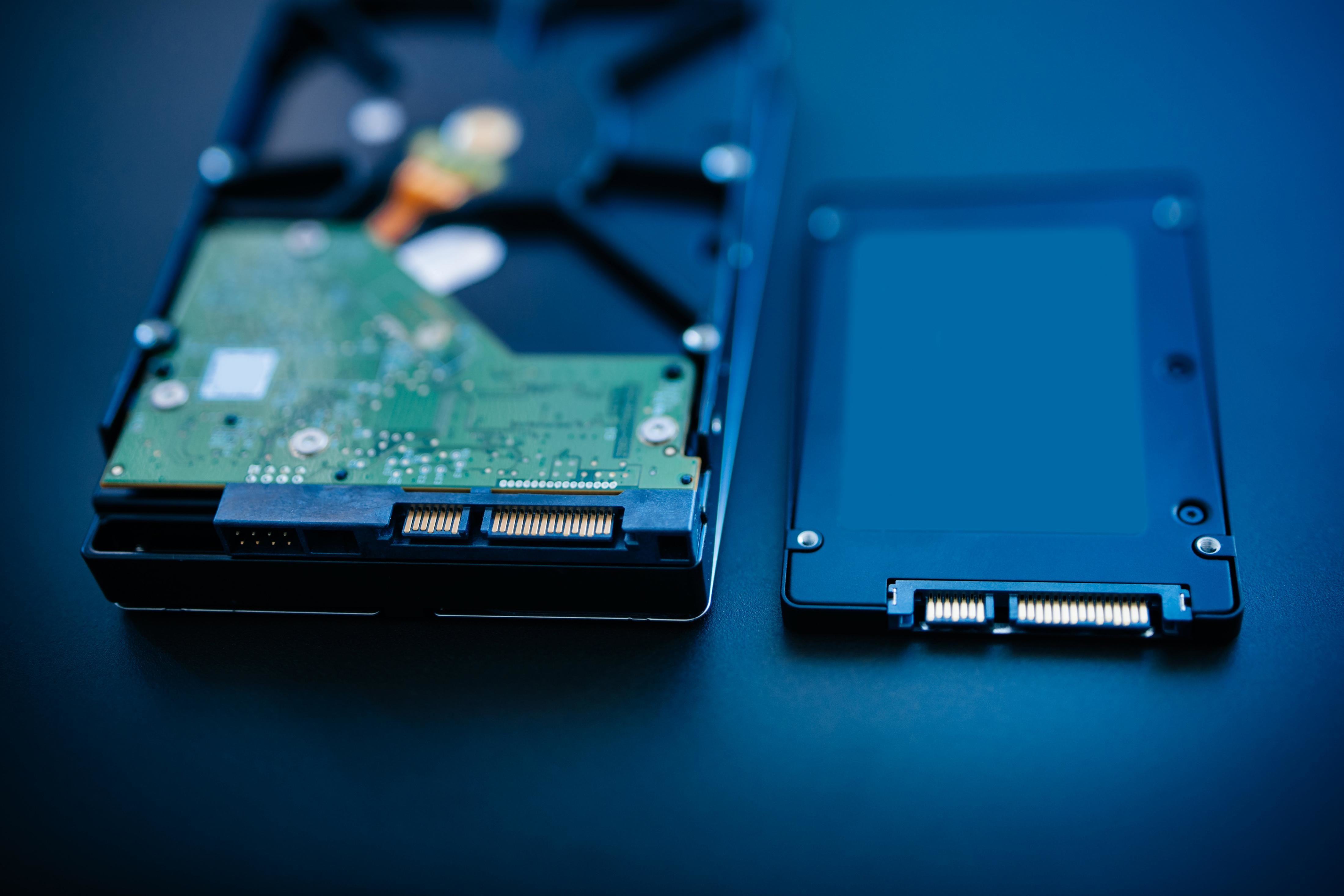One of the best bang for your buck upgrades you can make for your computer is a solid state drive (SSD). Of course it depends on what your computer already has, and how you use it, but for me - when I often restart because I dual boot windows and linux and I was still working off an old platter disk, it made absolute sense. So this post is about my new SSD and how it compares to my old drives.
Traditional Hard Disk Drive (HDD) Vs. Solid State Drive (SSD)
Your typical hard drive used to be a couple of actual platters that stored data. It used magnets and had moving parts (the platters spun around), and was pretty good. For storage you generally want it to be big, fast and cheap, the trade off is you can only pick two of those. Platter hard drives are big and cheap, if you need a bunch of storage and don’t want to break the bank a hard drive is for you.
A traditional hard drive (image from wikipedia), you can see the arm and the platter - each time you access data the platter has to spin around to the correct position.
For a few years now solid state drives have been gaining ground as the standard storage device, especially in smaller devices like phones and laptops. They are smaller, don’t have moving parts, use less power and are much faster than traditional hard disk drives. They are also more expensive. A 4TB hard disk drive is generally a couple dollars cheaper than a 512GB SSD (that’s 0.5TB). So if you want the best of both worlds a mixed setup is the way to go, a SSD for important data that is accessed often and a HDD that stores large amounts of data. That’s my new setup, a SSD to store my operating system so it can boot up fast, and a couple HDDs to store large data files.
So just how much faster are SSDs?
Right after installing my new SSD it was clearly faster. The first thing I measured was boot times, I like to play computer games and I also like to use a linux OS. Most of my games are on windows so I have to restart my computer to play them, and when it takes a few minutes to restart it can get annoying - especially if I feel like playing a game then change my mind after 5mins.
Anyway, here are the measurements, the Boot Menu is a screen where I choose to boot to linux or windows:
| Storage Drive | Boot Menu (s) | Login Screen (mm:ss) | Useable Desktop (mm:ss) | Total Boot Time (mm:ss) | Shut Down (s) |
|---|---|---|---|---|---|
| Traditional HDD | 19.48 | 02:09.41 | 01:29.51 | 03:58.4 | 24.37 |
| New SSD | 19.44 | 00:09.88 | 00:12.41 | 00:41.73 | 14.70 |
As you can see, the SSD trounces my old hard drive, it’s even faster at shutting down. And while the SSD is a fresh OS install, I don’t see any program I install taking up another 3 minutes during boot.
And if that doesn’t convince you, I even ran some benchmarks, here is the HDD:
and the SSD:
The pertinent numbers here are the average read speed, average write speed and access time and the SSD is the clear winner by far in all categories. I’ve put these in a table as well:
| Storage Drive | Avg. Read (MB/s) | Avg. Write (MB/s) | Avg. Access Time (ms) |
|---|---|---|---|
| Traditional HDD | 158.8 | 106.1 | 18.39 |
| New SSD | 560.7 | 505.9 | .03 |
The read and write speed of the traditional hard drive is pretty close to 125MB/s, and that is an important number because it is how fast a 1Gbps network can transfer data. Most home networks are 1Gbps (not the connections to the outside world, but the connections between your computers in your home), so when transferring data between my laptop and desktop computer my network will support about 125MB/s. My old hard drive, on average will only be able to read 158MB/s (so if I am doing something that is using my hard drive that number will start to dip and my hard drive won’t be able to keep up with my network) and the average write is only 106MB/s, already below my network speed. (this isn’t the whole story - there’s RAM and buffers and overhead for network protocols, but it is a good general illustration of why traditional hard drives are becoming the bottleneck in a home network transfer). The SSD is well above the network speed and will have no problem keeping up with large home network data transfers.
Another thing I’d like to point out is the access times, you can really see that the old HDD with it’s moving parts is simply outclassed by the SSD.
And some more notes:
-
Modern SSDs are becoming so fast that the traditional interface can’t handle the speed. My SSD is not the fastest on the market, it still uses the same old interface that platter disks use. I’ve read that the upgrade from a SSD with the older interface to the newer one is a similar jump from an old HDD to a SSD.
-
RAID can mitigate the slow read and write times for traditional hard disks (RAID is combining multiple hard drives so they look like one to the computer). I am putting together a server with 6x3TB hard drives, I put them in RAID 0 (the fastest and most unsafe RAID level, one disk dies and all your data is gone) and I saw a read speed of 814MB/s. In RAID 5 (which is a little slower and a little safer) I saw read speeds of 450MB/s.



